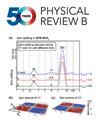强相关 f 电子系统单粒子特性中的铰链非赫米提趋肤效应
IF 3.7
2区 物理与天体物理
Q1 Physics and Astronomy
引用次数: 0
摘要
非赫米提系统表现出没有赫米提对应物的新现象,如例外点和非赫米提趋肤效应。这些非赫米拓扑现象可在格林函数描述的处于平衡状态的相关系统的单粒子激发中观察到。在本文中,我们展示了在描述 f 电子系统单粒子特性的有效哈密顿中出现的铰链非赫米提趋肤效应。趋肤效应导致对边界条件的强烈敏感性,当应用开放边界条件时,大量特征状态会定位在一个边界上。我们的系统就表现出了这种敏感性,并在铰链周围产生了集肤模式。这种铰链集肤效应是由表面布里渊区的非赫米拓扑结构引起的。在位于表面布里渊区一对例外点之间的一维子系统中,可以观察到铰链集肤模式。本文强调,相关材料是分析非ermitian 现象的一个令人兴奋的平台。本文章由计算机程序翻译,如有差异,请以英文原文为准。

Hinge non-Hermitian skin effect in the single-particle properties of a strongly correlated f-electron system
Non-Hermitian systems exhibit novel phenomena without Hermitian counterparts, such as exceptional points and the non-Hermitian skin effect. These non-Hermitian topological phenomena are observable in single-particle excitations of correlated systems in equilibrium, which are described by Green's functions. In this paper we demonstrate the appearance of the hinge non-Hermitian skin effect in the effective Hamiltonian that describes the single-particle properties of an -electron system. Skin effects result in a strong sensitivity to boundary conditions, and a large number of eigenstates localize at one boundary when open boundary conditions are applied. Our system exhibits such sensitivity and hosts skin modes localized around hinges. This hinge skin effect is induced by a non-Hermitian topology of the surface Brillouin zone. The hinge skin modes are observed for one-dimensional subsystems located between one pair of exceptional points in the surface Brillouin zone. This paper highlights that correlated materials are an exciting platform for analyzing non-Hermitian phenomena.
求助全文
通过发布文献求助,成功后即可免费获取论文全文。
去求助
来源期刊

Physical Review B
物理-物理:凝聚态物理
CiteScore
6.70
自引率
32.40%
发文量
0
审稿时长
3.0 months
期刊介绍:
Physical Review B (PRB) is the world’s largest dedicated physics journal, publishing approximately 100 new, high-quality papers each week. The most highly cited journal in condensed matter physics, PRB provides outstanding depth and breadth of coverage, combined with unrivaled context and background for ongoing research by scientists worldwide.
PRB covers the full range of condensed matter, materials physics, and related subfields, including:
-Structure and phase transitions
-Ferroelectrics and multiferroics
-Disordered systems and alloys
-Magnetism
-Superconductivity
-Electronic structure, photonics, and metamaterials
-Semiconductors and mesoscopic systems
-Surfaces, nanoscience, and two-dimensional materials
-Topological states of matter
 求助内容:
求助内容: 应助结果提醒方式:
应助结果提醒方式:


